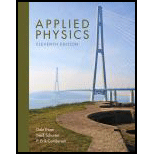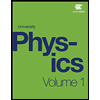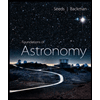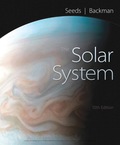
Applied Physics (11th Edition)
11th Edition
ISBN: 9780134159386
Author: Dale Ewen, Neill Schurter, Erik Gundersen
Publisher: PEARSON
expand_more
expand_more
format_list_bulleted
Textbook Question
Chapter 11.3, Problem 3P
Find the orbital velocity for Mercury as it orbits the sun.
Expert Solution & Answer
Want to see the full answer?
Check out a sample textbook solution
Students have asked these similar questions
Which object is located at one foci of the elliptical orbit of Mars
Why does a satellite need no fuel to move round a planet in a fixed orbit?
Find the mass of Jupiter based on the fact that Io, its innermost moon, has an average orbital radius of 421,700 km and a period of 1.77 days.
Chapter 11 Solutions
Applied Physics (11th Edition)
Ch. 11.1 - Compare the gravitational force that (a) the earth...Ch. 11.1 - Find the gravitational force between the sun and...Ch. 11.1 - Find the gravitational force between the sun and...Ch. 11.1 - Find the gravitational force between the sun and...Ch. 11.1 - Find the gravitational force between the sun and...Ch. 11.1 - Explain why the gravitational force between the...Ch. 11.1 - A satellite is orbiting 3.22 105 m above the...Ch. 11.1 - If the satellite in Problem 7 is orbiting at twice...Ch. 11.1 - What is the gravitational force exerted between an...Ch. 11.1 - The Apollo 16 lunar module had a mass of 4240 kg....
Ch. 11.3 - The moon orbits 3.84 108 m from the earth. How...Ch. 11.3 - The moon orbits 3.84 108 m from the earth. How...Ch. 11.3 - Find the orbital velocity for Mercury as it orbits...Ch. 11.3 - Prob. 4PCh. 11.3 - Find the orbital velocity for Saturn as it orbits...Ch. 11.3 - Find the orbital velocity for Uranus as it orbits...Ch. 11.3 - Find the time Mercury takes to orbit the sun.Ch. 11.3 - Find the time the earth takes to orbit the sun.Ch. 11.3 - Find the time Saturn takes to orbit the sun.Ch. 11.3 - Find the time Uranus takes to orbit the sun.Ch. 11 - What type of force is related to the mass of...Ch. 11 - As the distance increases between two objects, the...Ch. 11 - As the mass of two objects increases, the...Ch. 11 - The mass of a satellite is increased. In order to...Ch. 11 - As the distance increases between a satellite and...Ch. 11 - Explain why the gravitational force that exists...Ch. 11 - What would happen to your weight on earth if the...Ch. 11 - What would happen to your weight on earth if the...Ch. 11 - Explain how a satellite in orbit is in a constant...Ch. 11 - According to Isaac Newton, how is the motion of a...Ch. 11 - Most planets actually have slightly elliptical...Ch. 11 - Does the mass of a satellite influence the time it...Ch. 11 - Two 0.300-kg apples are 25.0 cm apart from one...Ch. 11 - Two 65.0-kg people are standing 1.00 m apart. What...Ch. 11 - Find the weight of a 65.0-kg person on the earth...Ch. 11 - Find the weight of a 65.0-kg person on Jupiter (in...Ch. 11 - Find the weight of a 65.0-kg person on Pluto (in...Ch. 11 - If the moon orbited at one half the present...Ch. 11 - If the moon orbited at twice the present distance...Ch. 11 - If the moon orbited at four times the present...Ch. 11 - Using Newtons law of universal gravitation, find...Ch. 11 - If an 85.0-kg astronaut in a space shuttle orbits...Ch. 11 - The gravitational differences between the earth...Ch. 11 - (a) How far from the center of the earth must a...Ch. 11 - Prob. 3ACCh. 11 - Flight engineers for the Apollo Lunar Orbiter...Ch. 11 - (a) What is the gravitational force on a 65.7-kg...
Additional Science Textbook Solutions
Find more solutions based on key concepts
82. If you were on the Moon and you looked up and saw a new Earth, would it be nighttime or daytime on the Moon...
Conceptual Physical Science (6th Edition)
The enthalpy of combustion of a gallon (3.8 liters) of gasoline is about 31,000 kcal. The enthalpy of combustio...
An Introduction to Thermal Physics
Will the light given off by Earth’s surface easily travel back through the atmosphere to space or will it be ab...
Lecture- Tutorials for Introductory Astronomy
Around the geographic North Pole (or magnetic South Pole), Earth’s magnetic field is almost vertical. If an air...
University Physics Volume 2
Choose the best answer to each of the following. Explain your reasoning. The age of our solar system is about (...
The Cosmic Perspective Fundamentals (2nd Edition)
9. Blocks with masses of 1 kg, 2 kg, and 3 kg are lined up in a row on a frictionless table. All three are push...
Physics for Scientists and Engineers: A Strategic Approach, Vol. 1 (Chs 1-21) (4th Edition)
Knowledge Booster
Learn more about
Need a deep-dive on the concept behind this application? Look no further. Learn more about this topic, physics and related others by exploring similar questions and additional content below.Similar questions
- Find the mass of Jupiter based on the fact that I0 , its innermost moon, has an average orbital radius of 421,700 km and a period of 1.77 days.arrow_forwardFind the speed of a satellite in a stable circular orbit around the Moon at a height 1,000 km on its surface. (M (Moon) = 7.35 × 10^22 kg: R (Moon) = 1.74 × 10^3 km)arrow_forwardA 9.0 × 10 3 kg satellite with an orbital radius of 3.20 × 10 7 m orbits the earth at an altitude of 2.56 × 10 7 m. What is the orbital period?arrow_forward
- Which statement applies best to the orbit of a satellite? A. Satellites are objects in continual free fall. B. Earth's magnetic field keeps satellites from crashing to Earth. C. All satellites remain in orbit above a fixed position on Earth. D. Satellites closer to Earth maintain their orbits the longest.arrow_forwardWhat are the necessary conditions for a satellite to appear stationary?arrow_forwardA satellite moves in a circular orbit a distance of 1.6×105m above Earth's surface. Determine the speed of the satellite.arrow_forward
- A satellite with a mass of 2521 kg orbits around Earth. If the orbital period of the satellite is 72 earth hours, find: a. Altitude from the planets surface b. Speed c. Acceleration of gravity at that altitude.arrow_forwardWhat is the orbit radius of a satellite around Earth that has an orbit period of 24 hours?arrow_forwardThe Moon travels in a 3.8×105km radius orbit about Earth. Earth's mass is 5.97×1024kg. Determine the period TT for one Moon orbit about Earth using Newton's law of universal gravitation and Newton's second law.arrow_forward
- What is geostationary satellite?Give two functions of such a satellite.arrow_forwardChoose the BEST answer to the following: A satellite in Earth orbit is above Earth’s (a) atmosphere. (b) gravitational field. (c) Both. (d) Neither.arrow_forwardWhy doesn’t the moon crash into the Earth? Group of answer choices It’s outside the pull of Earth’s gravity. It has a sufficiently large orbital speed. The gravitational pull of the sun keeps it in orbit. None of the above.arrow_forward
arrow_back_ios
SEE MORE QUESTIONS
arrow_forward_ios
Recommended textbooks for you
 University Physics Volume 1PhysicsISBN:9781938168277Author:William Moebs, Samuel J. Ling, Jeff SannyPublisher:OpenStax - Rice University
University Physics Volume 1PhysicsISBN:9781938168277Author:William Moebs, Samuel J. Ling, Jeff SannyPublisher:OpenStax - Rice University Foundations of Astronomy (MindTap Course List)PhysicsISBN:9781337399920Author:Michael A. Seeds, Dana BackmanPublisher:Cengage Learning
Foundations of Astronomy (MindTap Course List)PhysicsISBN:9781337399920Author:Michael A. Seeds, Dana BackmanPublisher:Cengage Learning Stars and Galaxies (MindTap Course List)PhysicsISBN:9781337399944Author:Michael A. SeedsPublisher:Cengage Learning
Stars and Galaxies (MindTap Course List)PhysicsISBN:9781337399944Author:Michael A. SeedsPublisher:Cengage Learning

University Physics Volume 1
Physics
ISBN:9781938168277
Author:William Moebs, Samuel J. Ling, Jeff Sanny
Publisher:OpenStax - Rice University

Foundations of Astronomy (MindTap Course List)
Physics
ISBN:9781337399920
Author:Michael A. Seeds, Dana Backman
Publisher:Cengage Learning

Stars and Galaxies (MindTap Course List)
Physics
ISBN:9781337399944
Author:Michael A. Seeds
Publisher:Cengage Learning

Kepler's Three Laws Explained; Author: PhysicsHigh;https://www.youtube.com/watch?v=kyR6EO_RMKE;License: Standard YouTube License, CC-BY